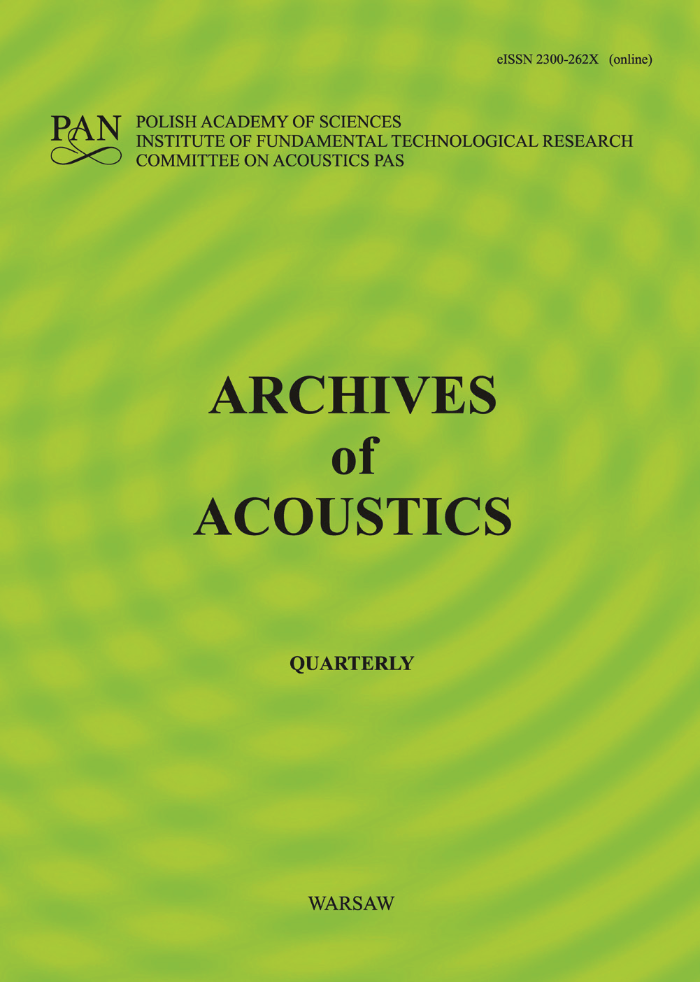Comparative Study of the Acoustic Efficiency of Prototype Sound Absorbing Panels Used in the Railway Track
Abstract
The article presents the results of comparative studies concerning the efficiency of systems aimed at minimising the acoustic nuisance of noise generated by the railway vehicle movement. The issue of noise in railway traffic is a significant challenge, affecting both human health and the quality of life in the vicinity of railway lines. Prototype sound absorbing panels with varied surface geometry, a rubber slab, and ballast layer (stone aggregate, grain size 31.5/50 mm) were examined. Experiments were conducted in a reverberation chamber, analysing the response to broadband noise excitation. The reverberation chamber allows for obtaining repeatable results, eliminating the influence of external sound sources. It enables the assessment of the sound absorption properties of various materials which makes it possible to determine their effectiveness in noise reduction. The research methodology included measurements of reverberation time in different frequency bands for an empty chamber and a chamber containing the tested materials. The obtained differences in reverberation times provide information on the influence of the tested material on the distribution of acoustic energy in individual frequency bands. The research results allow for a preliminary assessment of the effectiveness of the tested materials in the task of reducing railway line noise.
Keywords:
railway traffic noise, noise reduction, acoustic insulation, sound-absorbing materials, vibration damping, reverberation chamberReferences
- Andrés V.T., Martínez-Casas J., Carballeira J., Denia F.D., Thompson D.J. (2021), Railway rolling noise mitigation through optimal track design, [in:] Proceedings of the YIC 2021 – VI ECCOMAS Young Investigators Conference, https://doi.org/10.4995/YIC2021.2021.12583.
- Basner et al. (2014), Auditory and non-auditory effects of noise on health, The Lancet, 383(9925): 1325–1332, https://doi.org/10.1016/S0140-6736(13)61613-X.
- Bunn F., Zannin P.H.T. (2016), Assessment of railway noise in an urban setting, Applied Acoustics, 104: 16–23, https://doi.org/10.1016/j.apacoust.2015.10.025.
- Cao L., Fu Q., Si Y., Ding B., Yu J. (2018), Porous materials for sound absorption, Composites Communications, 10: 25–35, https://doi.org/10.1016/j.coco.2018.05.001.
- Castiñeira-Ibáñez S., Rubio C., Romero-García V., Sánchez-Pérez J.V., García-Raffi L.M. (2012), Design, manufacture and characterization of an acoustic barrier made of multi-phenomena cylindrical scatterers arranged in a fractal-based geometry, Archives of Acoustics, 37(4): 455–462, https://doi.org/10.2478/v10168-012-0057-9.
- Fediuk R., Amran M., Vatin N., Vasilev Y., Lesovik V., Ozbakkaloglu T. (2021), Acoustic properties of innovative concretes: A review, Materials, 14(2): 398, https://doi.org/10.3390/ma14020398.
- Glickman G.M., Bensing S.J., Carman R. (2011), An examination of trackbed sound absorptive panels for minimizing wayside noise from rail transit, [in:] NoiseCon Conference.
- Kraśkiewicz C. et al. (2024), Field experiment as a tool to verify the effectiveness of prototype track structure components aimed at reducing railway noise nuisance, Archives of Acoustics, 49(1): 61–71, https://doi.org/10.24425/aoa.2024.148770.
- Lee H.-J., Oh S.-T., Lee D.-J. (2016), An optimal mix design of sound absorbing block on concrete ballast in urban train tunnel, Journal of Korean Tunnelling and Underground Space Association, 18(1): 75–82, https://doi.org/10.9711/ktaj.2016.18.1.075.
- Leštinský L., Zvolenský P. (2019), New methods of noise reduction in railway carriages, Transportation Research Procedia, 40: 778–783, https://doi.org/10.1016/j.trpro.2019.07.110.
- Licitra G., Fredianelli L., Petri D., Vigotti M.A. (2016), Annoyance evaluation due to overall railway noise and vibration in Pisa urban areas, Science of the Total Environment, 568: 1315–1325, https://doi.org/10.1016/j.scitotenv.2015.11.071.
- Münzel T. et al. (2017), Effects of noise on vascular function, oxidative stress, and inflammation: Mechanistic insight from studies in mice, European Heart Journal, 38(37): 2838–2849, https://doi.org/10.1093/eurheartj/ehx081.
- Němec M., Danihelová A., Gergel' T., Gejdoš M., Ondrejka V., Danihelová Z. (2020), Measurement and prediction of railway noise case study from Slovakia, International Journal of Environmental Research and Public Health, 17(10): 3616, https://doi.org/10.3390/ijerph17103616.
- Shahidan S., Ramzi Hannan N.I.R., Md Maarof M.Z., Leman A.S., Senin M.S. (2017), A comprehensive review on the effectiveness of existing noise barriers commonly used in the railway industry, [in:] MATEC Web of Conferences, 87: 01007, https://doi.org/10.1051/matecconf/20178701007.
- Sun W., Liu L., Yuan H., Su Q. (2019), Influence of top shape on noise reduction effect of high-speed railway noise barrier, [in:] IOP Conference Series: Materials Science and Engineering, 493(1): 012043, https://doi.org/10.1088/1757-899X/493/1/012043.
- Sun Y., Yang L., Zheng J. (2020), Emission control areas: More or fewer?, Transportation Research Part D: Transport and Environment, 84: 102349, https://doi.org/10.1016/j.trd.2020.102349.
- Szczepański G., Podleśna M., Morzyński L., Włudarczyk A. (2023), Investigation of the acoustic properties of a metamaterial with a multi-ring structure, Archives of Acoustics, 48(4): 497–507, https://doi.org/10.24425/aoa.2023.146814.
- Vogiatzis K., Vanhonacker P. (2016), Noise reduction in urban LRT networks by combining track based solutions, Science of the Total Environment, 568: 1344–1354, https://doi.org/10.1016/j.scitotenv.2015.05.060.
- Zhang X., Thompson D., Quaranta E., Squicciarini G. (2019), An engineering model for the prediction of the sound radiation from a railway track, Journal of Sound and Vibration, 461: 114921, https://doi.org/10.1016/j.jsv.2019.114921.
- Zhao C., Wang P., Wang L., Liu D. (2014), Reducing railway noise with porous sound-absorbing concrete slabs, Advances in Materials Science and Engineering, 2014: 206549, https://doi.org/10.1155/2014/206549.
- Zvolenský P., Grenčí́k J., Pultznerová A., Kašíar L. (2017), Research of noise emission sources in railway transport and effective ways of their reduction, [in:] MATEC Web of Conferences, 107: 00073, https://doi.org/10.1051/matecconf/201710700073.







